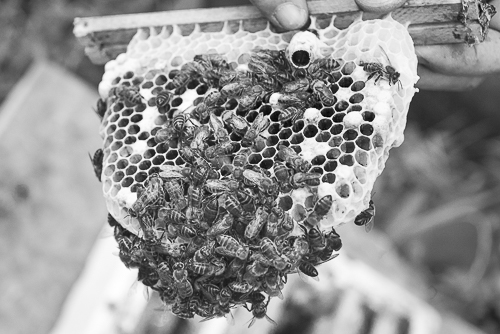Nutripolen derives from the Spanish words nutritivo meaning nutritious and polen, which means pollen.
We paid a visit to Laura, Jose Manuel and Jose who willingly showed us their beehives and related activities. First, we were invited to see their pollen, which the honey bees bring back on their bodies to the beehive when they have been pollinating flowers. Looking at the pollen, we could see a collection of mostly yellow and orange grains. Afterwards, they showed us how they sieve the pollen in a machine before they deep-freeze it such that it will preserve its characteristics for a long time. Besides pollen, Nutripolen also sells honey from Robinia pseoudoacacia, Eucalyptus and Erica. Their products are marketed under the name Morga and they sell them directly from their house and in specialised shops.
Jose Manuel and his wife Laura have been beekeepers for about 30 years, while Laura’s mother started even earlier. Going outside, we were shown their beehives, all of which looked quite small compared to the beehives we were using at the introductory course for beekeepers in Norway. Looking inside the beehives, it seemed that they only consisted of a structure called honey super, that is 10 vertical boards where the worker bees store nectar in honeycombs. Obviously, there are many ways to construct a beehive.
All of the bees were of the race Apis mellifera iberiensis and they had been actively bred to be be peaceful, produce lots of honey, taking care of larvae and being healthy. In order to demonstrate their peacefulness, Jose put the palm of his hand on top of the bees and my guide did the same without being stung.
About 10 years ago, a man from Mexico held a course about breeding queen bees in this area, but now only Nutripolen is following what he taught. In addition to the «normal» beehives, they also had beehives where they were breeding queen bees. They were using a structure which resembled a Jenter kit. Here, the queen will lay eggs, but the beekeepers will feed the larvae with royal jelly such that the larvae will be turned into queens. They also told my guide that the larvae always have to face up such that they can breathe. In general, there is a shortage of queen bees, meaning that Nutripolen sells their queen bees to other beekeepers.
They also showed us tiny boxes having, say, a volume of 1 litre, inside of which they were also raising queen bees. However, they showed us a queen cup, which had certainly been made by the worker bees themselves.
Unfortunately, the Asian predatory wasp has entered Spain and it is a great threat to both honey bees because they kill them. In order to fight the wasps, Nutripolen uses a solution originating in Korea: catch some of them live, cut off the two rear legs, which the wasps only use for cleaning themselves, put some honey mixed with poison on their bodies and release them. The wasps will return to their nests, bringing the poison back as well.
The wasps build huge nests, but unfortunately they are located in trees covered by foliage and they also build new nests every year, making it difficult to find them.
Below the beehives, Nutripolen had planted a small vineyard for making txakoli. Some years from now, maybe they can serve their customers txakoli with honey and pollen.

